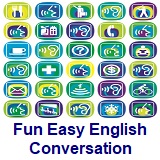|
|
| |
|
|
| |
|
|
| Fun Easy English Classroom May 3 |
|
| |
Classroom
Today
Learn about
indefinite articles |
|
 Indefinite
Articles Indefinite
Articles
Today in the Fun Easy English classroom you are going to
learn about indefinite articles an important part of
English grammar. |
 Hey
if you cannot understand something on this page, Hey
if you cannot understand something on this page,
then use the Fun Easy English
dictionary
(opens in a new window) |
|
|
|
 Grammar:
Indefinite
Articles Grammar:
Indefinite
Articles
Definition of an indefinite article. |
- An indefinite article:
- is the word "a", and the word "an"
in English
- indicates that the
noun refers to a general thing (Sit on
a chair) - means sit on any chair
- is used as a synonym for the number one, as in "make a
wish", "a hundred", "an apple" (an is an older spelling of
"one")
- is used to express a proportional relationship, such as
"a dollar a day" or "$50 an ounce"
- The following should be noted:
- use "a" before a
noun beginning with a
consonant sound (a chair, a table)
- use "an" before a
noun beginning with a
vowel sound (an apple, an
orange)
|
|
Indefinite
Article Examples |
- Sit on a chair (means any chair)
- You want to eat an apple. (means any apple)
- She wants to eat a banana. (means any
banana)
|
|
Fun Easy English Grammar Lessons |
|
 From
YOUR Teacher: Indefinite
Articles From
YOUR Teacher: Indefinite
Articles
Indefinite articles can be difficult to learn especially
knowing when to use them. In many cases an indefinite
article is not needed. English language students often
say the following incorrect statement.
Incorrect: Can you find a time to meet?
Correct: Can you find time to meet? |
|
|
|
|
|
Additional Lessons |
 About These
Lessons About These
Lessons
The following classroom lessons are great for students
who want additional conversation, listening, and reading
practice. |
-
Conversation Lesson -
Intermediate
Level. Dialogs for everyday use.
Short situational dialogs for students of English as
a Foreign (EFL) or Second (ESL) Language with a
written conversation and a conversation notes
section.
|
 Conversation Lesson
11 - Going for a Walk Conversation Lesson
11 - Going for a Walk
(Intermediate -
Conversation, Reading)
Dialogs for everyday use. Short situational dialogs for
students of English as a Foreign (EFL) or Second (ESL)
Language. |
Going for a Walk
Roger: What did you say?
Claire: I said that it’s a lovely day. Why
don’t we go for a walk?
Roger: Can you wait a few minutes? I have
to finish this letter.
Claire: Don’t take
too long. It would be a shame not to take advantage of such lovely
weather.
Roger: I won’t be long. No more than ten
minutes. Why don’t you go on ahead and I’ll meet
you in the park.
Claire: Believe I will.
Look for me near the rock garden. |
|
Conversation Notes |
- Don’t take too long
- Don’t delay
- go on ahead
- proceed (to the park)
- Look for me
- Meet me
|
|
Source: U.S. State Department |
|
Additional Conversation |
 Conversation Conversation
This is a collection of 30 situational conversations
which focus on a wide variety of communicative and
natural encounters in English....these
lessons are for beginning students. |
 Conversation Conversation
This is a collection of 30 situational conversations. Each conversation is
accompanied by language notes....these
lessons are for advanced students. |
 Conversation Conversation
English conversation lessons. 52
lessons covering pronunciation, speaking,
writing, and grammar topics....these
lessons are for beginning students. |
 Conversation Conversation
English conversation lessons. 30
lessons focusing mostly on communication and
grammar topics....these
lessons are for intermediate students. |
|
|
|
|
|
|
|
 Hey Students, Hey Students,
Use this dictionary and reference to look up any words you do not
understand in Fun Easy English.
Note: search opens in a new tab. |
|
|
|
|
|
Search Fun Easy English |
|
|
|
|
|
|
|
|
|
|
|
|
|
|
|
About
Contact
Copyright
Resources
Site Map |